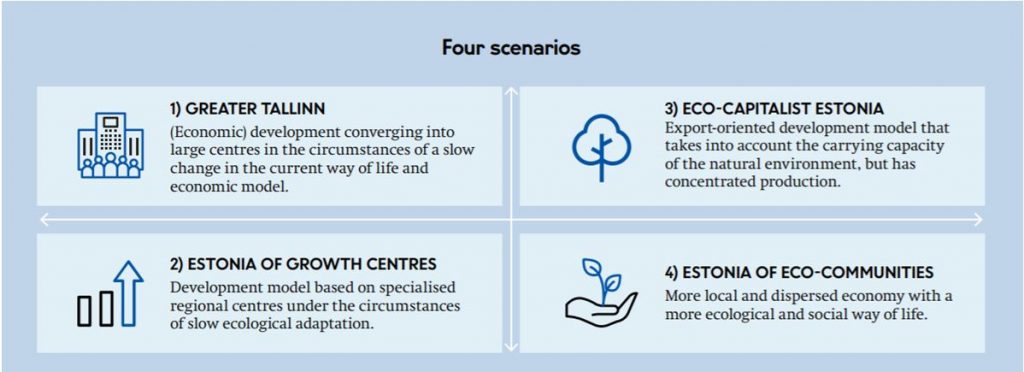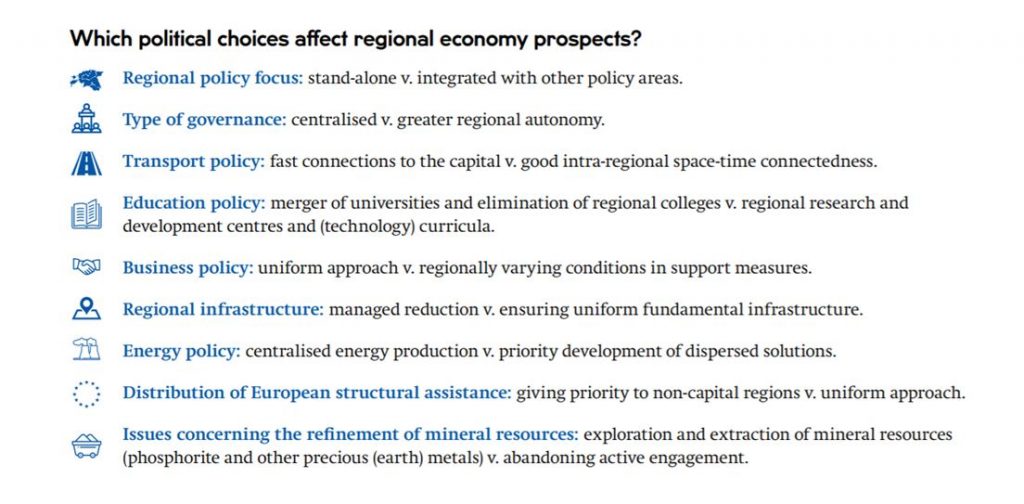Estonian regional policy has set out to implement the potential based on regional identity. So far, however, this has not been able to reverse the increasing concentration of economic activities into metropolitan regions.
Which technological innovations will affect the future of Estonian regions?
Major technological innovations in terms of regional economy are connected to information and energy technology:
- Industrial automation and robotisation alleviate labour shortage but aggravate income inequality;
- The Internet of Things/Everything (IoT/IoE) connects devices and communities;
- 3D-printing (additive manufacturing) supports decentralisation but requires higher expenses and special skills to set up;
- Self-driving vehicles may provide alleviation to the main problem of low density – great distances in space and time;
- Smart energy systems with distributed generation help to popularise renewable energy.
Which social and climate-related trends will affect the future of Estonian regions?
Population and society
- Estonia’s population is decreasing and ageing.
- The proportion of working-age population is decreasing but people are remaining in the labour market longer in their advanced years.
- Job-related mobility grows.
Health and work life
- New forms of work allow working regardless of location.
- People’s lifestyle becomes more health-conscious.
- New services emerge along with the increasing proportion of the elderly.
Environment and climate
- Warmer climate reduces heating costs and increases the competitiveness of agriculture.
- Extreme weather phenomena affect people’s sense of security.
- Indirect impact of climate change is reflected in the preference for products with a smaller environmental footprint in the global market. Immigration pressure increases as several regions in the world become unfit for habitation.
Regional economic scenarios 2035
Estonian regional economic scenarios outline alternative future worlds; they show what the nature and location of economic activities under the joint influence of various factors might look like in 2035. The scenarios intentionally amplify the developments due to the key factors, in order to outline the different development paths as clearly as possible. A multivariate concept of the future helps us to better understand which set of policy options would suit different situations – regional policy challenges require the contribution of a wide range of policy areas. One of the main axes of the scenarios is a change in the economic model and lifestyle connected to sustainable development – either a pragmatic approach dominates or an ecological rupture occurs. Another main axis is the impact of technological development on the economy – whether it increases concentration or supports dispersed economic activities.

Two principal options emerge in the situation:
- Accept a spatially highly concentrated economic model, and mitigate the negative aspects of the Greater Tallinn scenario, such as the deepening segregation and deteriorating living environment in the capital, and the scarcity of opportunities and general discontent in rural areas.
- Pursue a considerably more vigorous regional policy that would lead to the growth centres scenario. This would include developing regional growth sectors through various policies, not only the regional policy. High-speed Internet, smart grid, and good transport links to the nearest centre are of great importance.
Climate policy conclusions
To transition to a green economy model, we must estimate the ecological footprint of the current main sectors, as well as the specialisation suggested in county development strategies, looking for possibilities to adapt to stricter environmental restrictions and changing demands. Building up a new energy and transport infrastructure is costly and time-consuming, and therefore decisions must be made now.


 An independent think tank at the Riigikogu
An independent think tank at the Riigikogu 